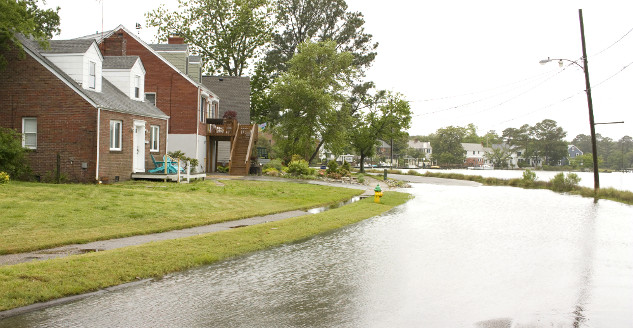
The U.S. East Coast is facing a critical environmental challenge: major cities are experiencing significant land sinking. A joint study by Virginia Tech and the U.S. Geological Survey has highlighted this alarming issue, highlighting the urgent need for awareness and action.
Subsidence, the gradual sinking of land, is occurring at an alarming rate of 2 mm per year along the East Coast. This phenomenon affects over 2 million people and 800,000 properties, presenting a significant challenge. Compared to the rise in global sea level, the impact of subsidence becomes even more pronounced.
Affected Areas and Their Challenges
Major cities along the U.S. East Coast, notably New York City, Long Island, Baltimore, Virginia Beach, and Norfolk, face the dire consequences of land subsidence. Each of these urban centers is grappling with unique challenges due to varying rates of ground sinking and rising sea levels.
In New York City, for example, the subsidence rate is a theoretical concern and a present reality affecting its dense infrastructure. The city's sprawling subway system, towering skyscrapers, and extensive underground utilities are increasingly at risk. With its lower elevation, Long Island faces a different set of challenges. The gradual sinking, coupled with the rise in sea level here, exacerbates the threat of coastal flooding, especially during high tides and storms, putting residential areas and commercial properties at risk.
Moving south, Baltimore and Virginia Beach present another set of issues. Baltimore's historic buildings and older infrastructure systems, already vulnerable due to age, are now further threatened by the steady descent of the ground beneath them. This subsidence introduces new stresses on building foundations, underground water, and sewage systems.
In Virginia Beach and Norfolk, the situation is equally concerning. These coastal cities are not only dealing with subsidence but also with the encroaching Atlantic. This dual threat jeopardizes critical infrastructure like roadways, runways, and naval installations. The sinking land in these areas also poses significant challenges for flood management and emergency response planning, as traditional methods may no longer be effective in these changing landscapes. The need for proactive measures and innovative solutions is evident as these cities confront the complex interplay of natural phenomena and urban development.
The Severity of the Situation
The situation along the U.S. East Coast is increasingly alarming, as recent findings have revealed the stark reality of land subsidence. Large swaths of the coast are sinking at a minimum rate of 2 mm per year, which might seem small in isolation but is significant when considered over time. This gradual yet persistent sinking is particularly acute in parts of the mid-Atlantic coast, where rates have been recorded at over 5 mm per year.
These figures become even more concerning when juxtaposed with the current global sea level rise rate of approximately 4 mm per year, a direct consequence of climate change. This dual phenomenon of land subsidence and rising sea levels means that some East Coast areas effectively see an aggregate increase in sea level impacts at nearly 9 mm per year. This accelerated change, translating to about 0.35 inches annually, poses immediate and long-term threats to coastal communities.
Looking forward, the implications of these compounded rates of change are profound. If current trends continue, the East Coast could experience inches of sea level rise in a relatively short timeframe, with projections indicating the possibility of feet of rise over the next few decades. This scenario is not just a distant possibility but a looming reality, given the current trajectory of climate change-induced sea level rise and unchecked land subsidence.
The inches of rise may not sound alarming in everyday terms. Still, in the context of coastal flooding and storm surge events, they represent a substantial increase in risk. The height of storm surges and the extent of flood zones are highly sensitive to even small sea-level changes. This means that inches of rise can translate into significantly more property damage, frequent flooding events, and increased risk to lives and livelihoods. This severe situation necessitates urgent attention and action in mitigating the underlying causes and adapting to the unavoidable changes already in motion.
Impact on Critical Infrastructure
The varying rates of land subsidence along the U.S. East Coast profoundly impact critical infrastructure, with different areas facing distinct challenges. The iconic JFK and LaGuardia airports are under significant threat in New York. These major transportation hubs, crucial for national and international travel, face the risk of operational disruptions and infrastructure damage due to land sinking.
The situation is similar for the extensive railway systems that connect the metropolis, including those running through Manhattan and Long Island. These areas deal with subsidence and the added threat of rising sea levels, which can lead to more severe and frequent flooding.
This combination poses a real risk to the underground transit systems, potentially causing costly damages and disruptions. Long Island, in particular, with its dense population and expensive infrastructure, faces a unique challenge as its low-lying areas become increasingly susceptible to flooding, threatening homes, businesses, and essential services.
Further south, the situation in Norfolk, Virginia, is equally concerning, especially given the presence of the critical Norfolk Navy Base. This base, a cornerstone of U.S. naval operations, is already experiencing the effects of subsidence and rising sea levels. The impact here extends beyond the base, affecting the surrounding infrastructure and the larger Chesapeake Bay area.
The Chesapeake region, known for its rich history and natural beauty, faces an existential threat from the encroaching waters, which could lead to significant ecological and economic consequences. The sinking land and rising sea levels could compromise the integrity of levees and other flood defenses, leading to heightened flood risks. This poses a significant challenge to military readiness and the resilience of the communities and ecosystems in the Chesapeake Bay area.
As these crucial areas continue to sink and sea levels rise due to climate change, the need for robust and forward-thinking solutions to protect and adapt our critical infrastructure has never been more urgent.
Risk Assessment and Future Implications
Within 100 km of the coast, the risks associated with land subsidence and rising sea levels are immense. Potential consequences include undermined building foundations, damaged utilities, and building collapses. Moreover, this subsidence exacerbates the effects of the rise in sea level on coastal flooding.
The research clearly shows the severity of land subsidence on the U.S. East Coast. These findings have profound implications for urban planning and infrastructure maintenance. It is a call to action for addressing this pressing issue in light of the research findings, urging immediate and effective measures to mitigate the impacts of this environmental challenge.
The study was published in the Proceedings of the National Academy of Sciences

Related Books:
The Future We Choose: Surviving the Climate Crisis
by Christiana Figueres and Tom Rivett-Carnac
The authors, who played key roles in the Paris Agreement on climate change, offer insights and strategies for addressing the climate crisis, including individual and collective action.
Click for more info or to order
The Uninhabitable Earth: Life After Warming
by David Wallace-Wells
This book explores the potential consequences of unchecked climate change, including mass extinction, food and water scarcity, and political instability.
Click for more info or to order
The Ministry for the Future: A Novel
by Kim Stanley Robinson
This novel imagines a near-future world grappling with the impacts of climate change and offers a vision for how society might transform to address the crisis.
Click for more info or to order
Under a White Sky: The Nature of the Future
by Elizabeth Kolbert
The author explores the human impact on the natural world, including climate change, and the potential for technological solutions to address environmental challenges.
Click for more info or to order
Drawdown: The Most Comprehensive Plan Ever Proposed to Reverse Global Warming
edited by Paul Hawken
This book presents a comprehensive plan for addressing climate change, including solutions from a range of sectors such as energy, agriculture, and transportation.


























